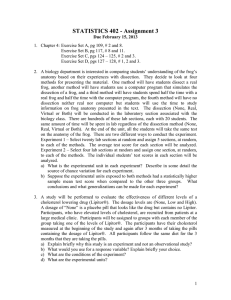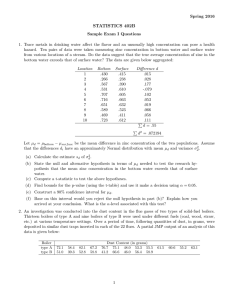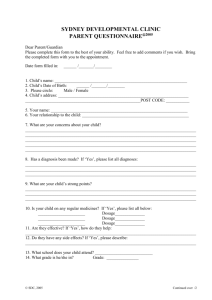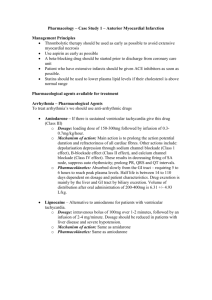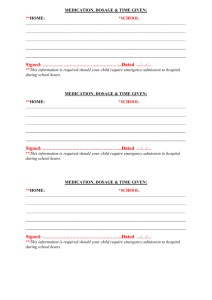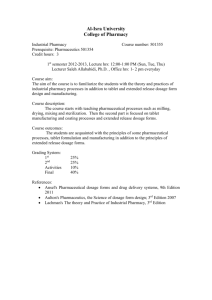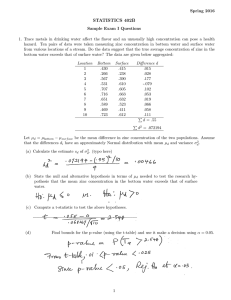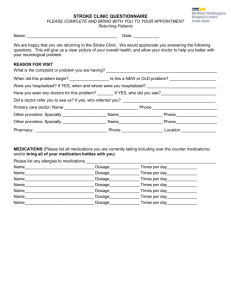Statistics 402B February 18, 2011
advertisement
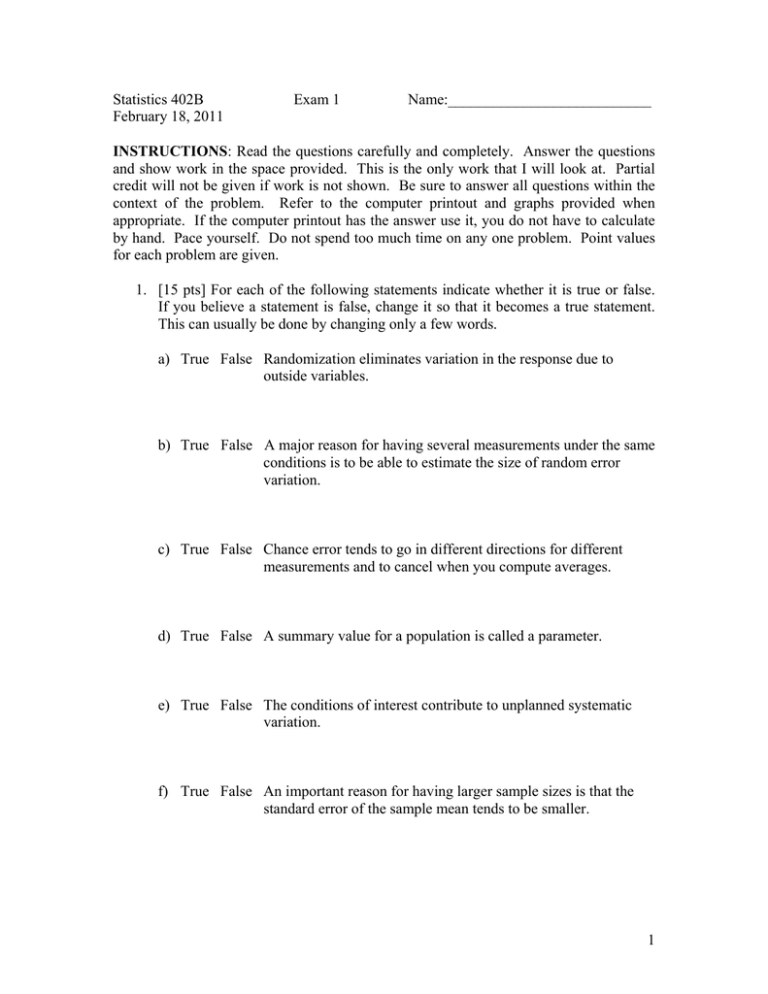
Statistics 402B February 18, 2011 Exam 1 Name:___________________________ INSTRUCTIONS: Read the questions carefully and completely. Answer the questions and show work in the space provided. This is the only work that I will look at. Partial credit will not be given if work is not shown. Be sure to answer all questions within the context of the problem. Refer to the computer printout and graphs provided when appropriate. If the computer printout has the answer use it, you do not have to calculate by hand. Pace yourself. Do not spend too much time on any one problem. Point values for each problem are given. 1. [15 pts] For each of the following statements indicate whether it is true or false. If you believe a statement is false, change it so that it becomes a true statement. This can usually be done by changing only a few words. a) True False Randomization eliminates variation in the response due to outside variables. b) True False A major reason for having several measurements under the same conditions is to be able to estimate the size of random error variation. c) True False Chance error tends to go in different directions for different measurements and to cancel when you compute averages. d) True False A summary value for a population is called a parameter. e) True False The conditions of interest contribute to unplanned systematic variation. f) True False An important reason for having larger sample sizes is that the standard error of the sample mean tends to be smaller. 1 2. [24 pts] The following is excerpted from an article that appeared in the May 15, 2009 Des Moines Register. Study finds ginger cuts chemo nausea Ginger, long used as a folk remedy for soothing tummy aches, helped tame one of the most dreaded side effects of cancer treatment – nausea from chemotherapy – the first large study to test the herb for this has found. The study involved 644 patients from cancer centers around the nation who had suffered nausea in a previous round of chemotherapy. The patients were placed in four groups and given one of three doses of ginger (the equivalent of ½ gram, 1 gram or 1 ½ grams of ginger per day) or dummy capsules that contain no ginger. All patients were given standard anti-sickness medicines. Patients took the capsules for six days, beginning three days before chemo. All of the ginger doses significantly reduced nausea, and the middle and lowest doses gave the best results. Those given dummy pills reported hardly any relief. a) [2] What is the response? Be specific. b) [3] What are the conditions? Be specific. c) [2] What is the experimental material? Be specific d) [3] Is there a control group in the experiment? Explain briefly within the context of the problem. e) [4] Randomization is not mentioned in the excerpt above. randomization have been used in this experiment? How should 2 f) [3] Replication is not mentioned in the excerpt above. How should replication have been used within this experiment? g) [3] What is the source of planned systematic variation in this experiment? Explain briefly. h) [4] What are the sources of random error variation in this experiment? Explain briefly. 3. [6 pts] Suppose you have two sets of subjects available for a study on attitudes toward gay marriage. The first set is more uniform (e.g. same sex, same ethnic group, same religion, etc.) while the second set is less uniform (e.g. different sexes, different ethnic groups, different religions, etc.). a) [3] Chance errors are likely to be smaller using which set? Explain briefly. b) [3] Bias is likely to be smaller using which set? Explain briefly. 3 4. [25 pts] An experiment is performed on individuals with elevated serum cholesterol. The individuals are treated with Lipitor ®. The dosage levels are (None, Low and High). A dosage of “None” is a placebo pill that looks like the drug but contains no Lipitor. At the beginning of the study the total cholesterol for each individual is determined. Individuals are randomly assigned to the three groups so that the same number of individuals is in each group. At the end of three months the total cholesterol for each individual is determined again. The change in cholesterol is calculated (Three Month Value – Beginning Value) so that a negative change means the total cholesterol has decreased. a) [3] What are the response, conditions and material? b) [2] A total of 54 individuals are randomly assigned to treatment combinations of the type of drug and dosage level. For Alpha = 0.05 and Beta = 0.10 what is the size of the difference in dosage level means that can be detected? The experiment, as described above, is performed. Refer to the JMP output for the Lipitor ® Experiment. c) [4] Test the hypothesis that the dosage effects are zero H 0 : 1 2 3 0 against the alternative that at least one is not zero. Be sure to report the appropriate test statistic, P-value, decision, reason for the decision and a conclusion within the context of the problem. Use 0.05 . d) [5] The t* value for Fisher’s Least Significant Difference ( 0.05 ) is 2.00758. Compute the LSD for comparing dosage level means. Use this LSD to indicate which dosage levels have statistically significant differences in their sample means and which don’t. 4 e) [4] Report the value for Tukey-Kramer HSD. Use this HSD to indicate which dosage levels have statistically significant differences in their sample means and which don’t. f) [3] Comment on the plot of residuals versus dosage level and the standard deviations of the residuals. What does this plot tell you about the Fisher conditions necessary for conducting a formal statistical analysis? g) [4] Comment on each plot in the distribution of residuals. What does this tell you about the Fisher conditions necessary for conducting a formal statistical analysis? Do not write below this line. 5
